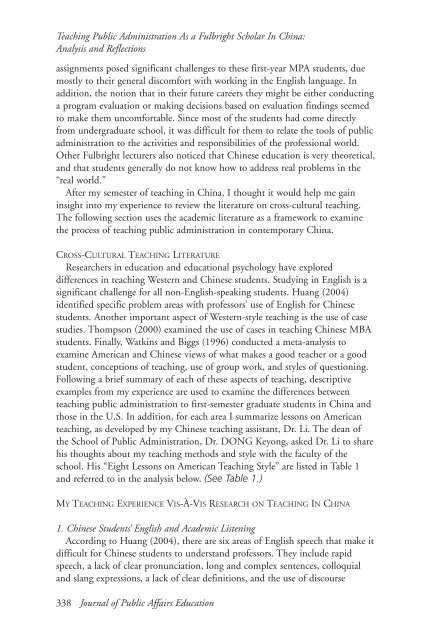journal of public affairs education - NASPAA *The Global Standard ...
journal of public affairs education - NASPAA *The Global Standard ...
journal of public affairs education - NASPAA *The Global Standard ...
- No tags were found...
You also want an ePaper? Increase the reach of your titles
YUMPU automatically turns print PDFs into web optimized ePapers that Google loves.
Teaching Public Administration As a Fulbright Scholar In China:Analysis and Reflectionsassignments posed significant challenges to these first-year MPA students, duemostly to their general discomfort with working in the English language. Inaddition, the notion that in their future careers they might be either conductinga program evaluation or making decisions based on evaluation findings seemedto make them uncomfortable. Since most <strong>of</strong> the students had come directlyfrom undergraduate school, it was difficult for them to relate the tools <strong>of</strong> <strong>public</strong>administration to the activities and responsibilities <strong>of</strong> the pr<strong>of</strong>essional world.Other Fulbright lecturers also noticed that Chinese <strong>education</strong> is very theoretical,and that students generally do not know how to address real problems in the“real world.”After my semester <strong>of</strong> teaching in China, I thought it would help me gaininsight into my experience to review the literature on cross-cultural teaching.The following section uses the academic literature as a framework to examinethe process <strong>of</strong> teaching <strong>public</strong> administration in contemporary China.CROSS-CULTURAL TEACHING LITERATUREResearchers in <strong>education</strong> and <strong>education</strong>al psychology have exploreddifferences in teaching Western and Chinese students. Studying in English is asignificant challenge for all non-English-speaking students. Huang (2004)identified specific problem areas with pr<strong>of</strong>essors’ use <strong>of</strong> English for Chinesestudents. Another important aspect <strong>of</strong> Western-style teaching is the use <strong>of</strong> casestudies. Thompson (2000) examined the use <strong>of</strong> cases in teaching Chinese MBAstudents. Finally, Watkins and Biggs (1996) conducted a meta-analysis toexamine American and Chinese views <strong>of</strong> what makes a good teacher or a goodstudent, conceptions <strong>of</strong> teaching, use <strong>of</strong> group work, and styles <strong>of</strong> questioning.Following a brief summary <strong>of</strong> each <strong>of</strong> these aspects <strong>of</strong> teaching, descriptiveexamples from my experience are used to examine the differences betweenteaching <strong>public</strong> administration to first-semester graduate students in China andthose in the U.S. In addition, for each area I summarize lessons on Americanteaching, as developed by my Chinese teaching assistant, Dr. Li. The dean <strong>of</strong>the School <strong>of</strong> Public Administration, Dr. DONG Keyong, asked Dr. Li to sharehis thoughts about my teaching methods and style with the faculty <strong>of</strong> theschool. His “Eight Lessons on American Teaching Style” are listed in Table 1and referred to in the analysis below. (See Table 1.)MY TEACHING EXPERIENCE VIS-À-VIS RESEARCH ON TEACHING IN CHINA1. Chinese Students’ English and Academic ListeningAccording to Huang (2004), there are six areas <strong>of</strong> English speech that make itdifficult for Chinese students to understand pr<strong>of</strong>essors. They include rapidspeech, a lack <strong>of</strong> clear pronunciation, long and complex sentences, colloquialand slang expressions, a lack <strong>of</strong> clear definitions, and the use <strong>of</strong> discourse338 Journal <strong>of</strong> Public Affairs Education
















